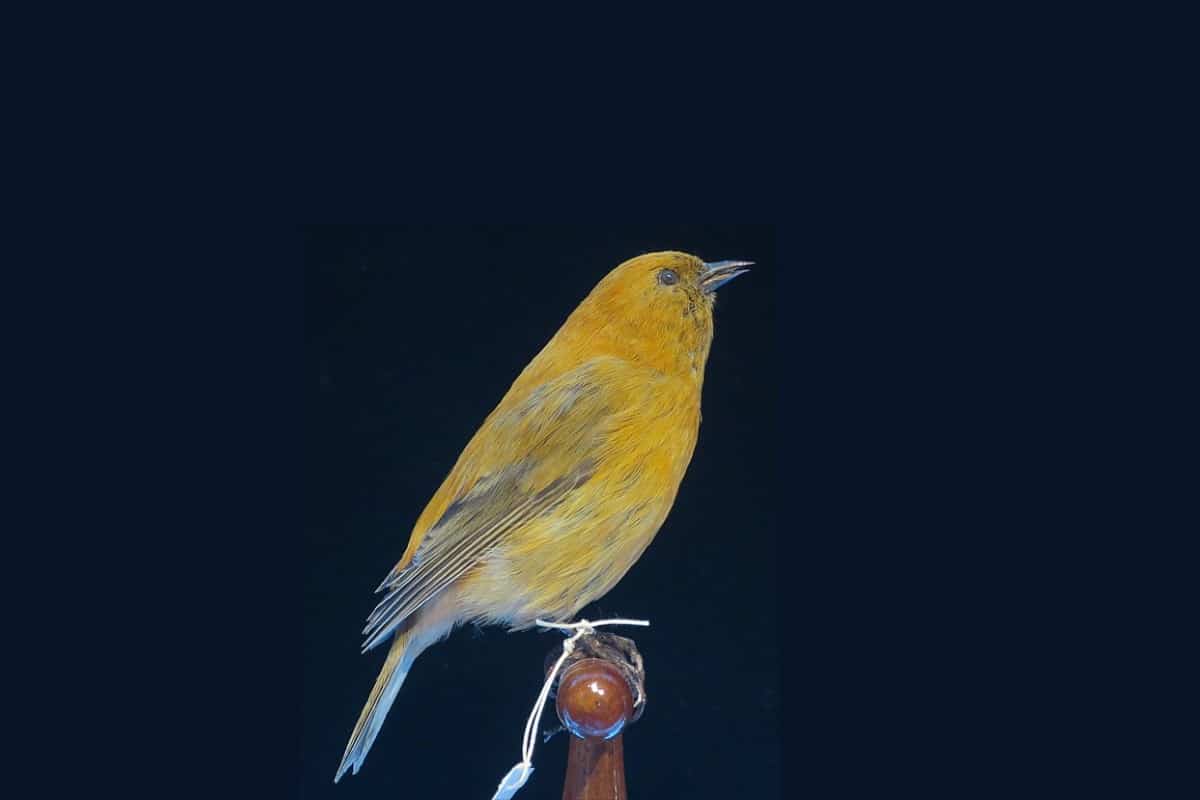Common Name: Maui ʻAkepa
Scientific Name: (Loxops ochraceus)| Size | Diet | Range in Hawaii | Status in Hawaii |
|---|---|---|---|
| 4 in. | small arthropods, insects and nectar | Maui | Critically Endangered |
The Maui ʻakepa (Loxops ochraceus) is a fascinating and unique bird species that are native to the island of Maui in Hawaii. With its distinctive yellow plumage and playful behavior, this honeycreeper was a beloved sight in its natural habitat.
Sadly, the species is believed to be extinct, with the last confirmed sighting dating back to 1988. In this article, we’ll explore the fascinating world of the Maui ʻakepa, its role in Hawaii’s ecosystem, and the circumstances that led to its probable extinction.
Maui ʻAkepa
Appearance
The Maui ‘Akepa is a visually striking bird with distinct features. It has a small and compact body, measuring approximately 4 inches (10 centimeters) in length. The male Maui ‘Akepa showcases vibrant colors, with a bright yellow plumage adorning its head, neck, breast, and underparts.
Its wings and back display an eye-catching shade of olive-green. In contrast, the female Maui ‘Akepa has a more subdued coloration, typically with a duller yellow or olive-brown plumage. Both males and females have short, pointed bills that are adapted for their specialized feeding habits.
Diet
The Maui ‘Akepa has a specialized diet that primarily revolves around nectar from native flowering plants. It uses its short, pointed bill to access the nectar hidden within the flowers. In addition to nectar, the Maui ‘Akepa also consumes small insects and arthropods as a source of protein.
It forages among the vegetation, searching for insects to supplement its nectar-based diet. This unique feeding behavior highlights the Maui ‘Akepa’s role as a nectarivorous bird and its reliance on specific plant species for sustenance.
Nesting
The nesting behavior of the Maui ‘Akepa is not well-documented due to the scarcity of recent observations. However, like other honeycreepers, it is believed to construct cup-shaped nests made of plant materials such as twigs, moss, and leaves.
The female Maui ‘Akepa is responsible for building the nest, typically placed in the fork of a tree branch to provide stability and protection. The exact location and height of the nests within the forest canopy may vary. The female lays one to two eggs per clutch, and both parents likely take turns incubating the eggs and caring for the hatchlings.
Behavior
The Maui ‘Akepa is an active and agile bird, displaying behaviors typical of other honeycreepers. It moves swiftly through the forest canopy in search of food, utilizing its specialized bill to extract nectar from flowers. The Maui ‘Akepa’s diet primarily consists of nectar, supplemented with small insects and arthropods.
During the breeding season, the Maui ‘Akepa is believed to form monogamous pairs. The female constructs a cup-shaped nest using plant materials such as twigs, moss, and leaves. She lays one to two eggs, which are likely incubated and cared for by both parents.
While specific details about the Maui ‘Akepa’s vocalizations and social behavior are not extensively documented, like other birds, they may use vocal signals for communication within their species, including territorial defense and courtship displays.
Habitat
The Maui ʻAkepa was a bird species that was native to the island of Maui in Hawaii. Its habitat was primarily the upper elevation mesic and wet forests of the island, where it foraged for insects and other small invertebrates. The Maui ʻAkepa was known to prefer areas with mature ʻōhiʻa trees, which provided a key food source in the form of the tree’s nectar.
Range

via Wikimedia Commons
The Maui ‘Akepa is endemic to the island of Maui in Hawaii. Its range is primarily associated with the upper slopes of Haleakala, reaching elevations of 1,000-2,000 meters above Olinda. Sightings and specimen collections indicate that the species was locally abundant on the northwest slopes of Haleakala.
However, the exact extent of its range and current population status are uncertain, and there is a possibility that the Maui ‘Akepa may now be extinct or close to extinction. Ongoing surveys and research efforts are essential for further understanding the species’ range and conservation needs.
Conservation Status
The conservation status of the Maui ‘Akepa is critically endangered. Historical records suggest that the species was once locally abundant on the northwest slopes of Haleakala on Maui. However, sightings and documentation of the Maui ‘Akepa have become scarce, and it is believed to have declined significantly, possibly to the point of extinction.
The primary threats to the species include disease, habitat deterioration caused by cattle and pigs, and potential predation by non-native species. The Maui ‘Akepa has been listed as endangered by the U.S. Fish and Wildlife Service and the State of Hawaii. Continued conservation efforts, habitat restoration, and research are vital for the potential recovery and preservation of this endangered species.
Interesting Facts
1. Limited range
The Maui ‘Akepa is restricted to the upper slopes of Haleakala, primarily in the montane forests of Maui.
2. Nectarivorous Diet
These birds primarily feed on nectar from native flowering plants, utilizing their specialized bills to access the sweet liquid. They also consume small insects and arthropods for additional protein.
3. Vibrant plumage
Male Maui ‘Akepas exhibit vibrant yellow plumage on their head, neck, breast, and underparts, complemented by an olive-green color on their wings and back. Females have a more subdued coloration.
4. Specialist feeder
The Maui ‘Akepa’s bill is uniquely adapted for its specialized diet of nectar and small insects, allowing it to access hidden nectar sources within flowers.
Frequently Asked Questions
1. Are there any conservation efforts in place for the Maui ʻAkepa?
Yes, there are active conservation efforts focused on habitat restoration, captive breeding programs, predator control, and public awareness campaigns to protect and preserve the Maui ʻAkepa.
2. What does the Maui ʻAkepa look like?
Male Maui ʻAkepas have vibrant yellow plumage on their head, neck, breast, and underparts, with olive-green wings and back. Females have a more subdued coloration.
3. How long do Maui ʻakepas live?
While specific lifespan data for the Maui ʻakepa is limited, honeycreepers in general have been known to live for several years. It is estimated that they have a lifespan of around 5 to 10 years in the wild. However, various factors such as habitat quality, predation, and disease can influence their survival and overall lifespan.




